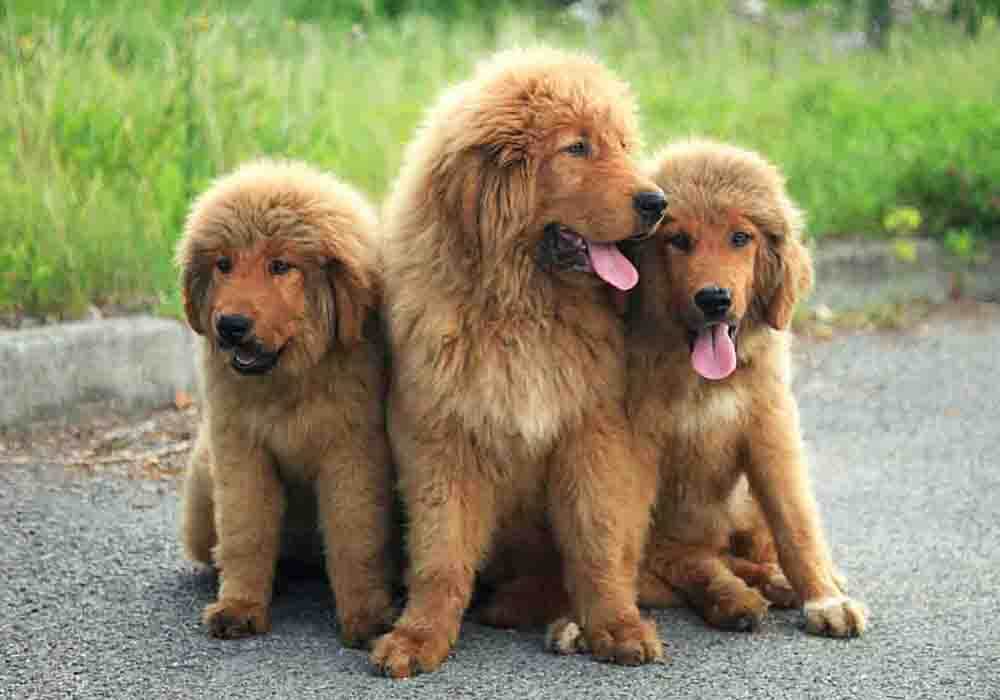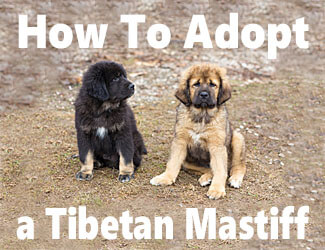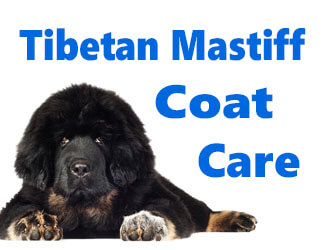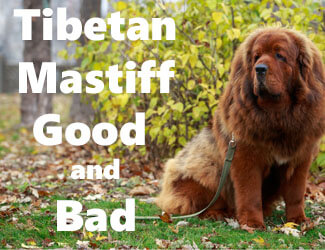Are Tibetan Mastiffs
Good Pets
Or Family Dogs?
Your Top Questions Answered
by Ken Alden
Tibetan Mastiffs are primarily a working dog
and do well in an environment where they have an ample outdoor area. Their
impressive size and appearance resemble a lion, including a full head of fluffy
fur. However, this breed of dog is still more
primitive than most dog breeds, and this causes
concern about how well they’ll fit into a human family.
Are Tibetan Mastiffs Good Pets Or Family Dogs?
Tibetan Mastiffs can make good pets or family dogs though not without lots of training. If you train them correctly, a Tibetan Mastiff can be a fiercely loyal and protective family companion. However, this breed is not right for the majority of pet parents due to its aggressive and territorial nature.
Tibetan Mastiffs can be a difficult breed to domesticate if you don't have the proper experience and confidence. Before you decide to adopt this breed, read on to learn some essential details and to read the answers to some of the most commonly asked questions about this breed. Read More Below...
Pro-tip: Ever try lifting a Tibetan Mastiff? Their weight can hurt not only your back but their joints when they hop down from cars, sofas or even your bed. To protect your back and theirs check out the best Mastiff ramps on Amazon.com now.

Are Tibetan Mastiffs Friendly?
With the proper socialization and discipline, Mastiffs can be loving, loyal, and friendly to their entire family.
However, are Tibetan Mastiffs good pets? TMs are still a lot like their ancestors in that they care more about guarding what's theirs rather than getting cuddles. This breed of dog won't show much affection like licking and laying in your lap. They're happy to be left alone to keep a watchful eye on their turf.
This breed will be extremely territorial of
his home, yard, people, and even the street he walks down. It's vital to change
scenery during your walks so that your pet doesn't become aggressive in a
public area.
Start Socializing Early in Your Mastiff’s Life for Best Results
Socialization is a crucial part of making sure your pet knows how to behave appropriately around people, both familiar and strangers. This stage should occur as early as when you bring your puppy into the home.
You should start taking your fur baby out into the world as soon as he's been cleared by his veterinarian to no longer be at risk of catching illnesses. This period will usually be after they've started their immunizations, at around eight weeks.
Socialization will include walks to the park,
supervised playtime at a dog park so your Mastiff can learn how to get along
with other animals. You can also add interaction with your family, friends, and
anyone that will be a staple presence in your life and home.

Having a well socialized Mastiff is a vitally import step to ensuring that they become a good (and not aloof) pet. Here's an article which will give you important steps to a friendlier Tibetan Mastiff.
Tibetan Mastiffs and Strangers
Don't expect your Mastiff to give a warm welcome to strangers you invite inside your home, especially if they have furry companions accompanying them.
Some Tibetan Mastiffs refuse to allow anyone other than family inside their house and will require separation when you have house guests. If your pet doesn't seem to be accepting of your new visitor, it's best to put them somewhere separate rather than letting them continue to be agitated. are tibetan mastiffs good pets
Other Mastiffs can be tolerant of strangers if
you make them feel comfortable enough with their presence. Usually, your pet
will read your behavior and mirror it. If you're relaxed and friendly towards
someone, your Mastiff will be too. Just don't expect them to allow strangers to
do any touching or petting.
Are Tibetan Mastiffs Good Family Dogs?
It's important to know whether a dog would be a safe addition to your family before adoption. Not all breeds are suitable for homes with children.
The good news is that Tibetan Mastiffs form an intense bond with their family and become attuned to their emotions. Once a Mastiff bonds with his family, there's nothing your pet won't do to keep you safe.
However, this protectiveness can be a downside
as this breed of dog does not do well in homes where there will be a lot of
arguing and yelling. Their loyalty and protective instincts can cause them to
misinterpret the situation and become aggressive. This is true even when it's a
play fight and no harm is occurring.
Tibetan Mastiffs and Children
When raised with children, Tibetan Mastiffs will be severely protective of their charges. Never let your children rough house around a TM, nor should you discipline your children in front of your pet. Their protective nature can make them try to defend their family, even when there's no danger.
If you're going to be letting your children around a large breed dog like a TM, it's important to start socializing them as early as possible. And make sure that your children know how to behave correctly around your pet.
DO NOT let them pull your pet's ears, tails,
or try to take toys or food away. With young babies and toddlers, as well as
smaller children or people with stability issues, it's best to use supervision
around a large dog like the Tibetan Mastiff because their large size can be an
accident waiting to happen.

Learn even more about this important topic about how Tibetan Mastiffs get along with kids in this article dedicated to just this topic.
Pro-tip: Tibetan Mastiff anxiety, aggression, destructive chewing, jumping up, fearfulness, and other behaviors can be controlled with the right training program.
Here’s a great course that addresses these issues along with many other dog training basics: Check it out now!
Are Tibetan Mastiffs Good With Other Dogs and Cats?
Tibetan Mastiffs can live in a home with multiple animals, but you have to be cautious of dogs of the same sex.
Tibetans don't do well with same-sex dogs regardless of if they're both male or female. The most important thing is to make sure that your Tibetan has plenty of quality time away from other pets.
Having a cat in the home can be a complication
for some Tibetan parents. This breed of dog has an ingrained sense of hunting
and loves a chase. So, when they see a cat darting across the room, their first
instinct is to give chase.
Tibetan Mastiffs Are Working Dogs
Throughout history, Tibetan Mastiffs have served as guard dogs for small towns, monasteries, and to protect livestock. They still do well in the role of a working dog, in addition to being a family pet.
These dogs are great living on farms where
they have the opportunity to herd animals and keep them safe from predators.
For this reason, they can form a tight, protective bond with their charges,
which includes other animals such as goats, sheep, cattle, or even birds like
chickens.
Are Tibetan Mastiffs Easy to Train?
If you're used to docile dogs that love to play games and obey commands, you could face problems trying to assert the necessary control over a breed as headstrong and stubborn as a Tibetan Mastiff.
This breed can be challenging to train and will frequently show resistance and disobedience just because they're not in the mood to listen. You might experience many problems getting your Mastiff to obey, so you must have experience establishing dominance and control over difficult animals.
TMs are not for first-time pet
parents. This breed needs someone who will know how to be strict but loving.
Raising this type of dog also requires consistency. If you don't have a lot of
time to devote to ongoing training and socializing, you shouldn't adopt a
Tibetan.
Consider a Professional Trainer
While you must know how to use firm control when training your Tibetan Mastiff, it can also be a good idea to start your fur child off with a professional trainer.
When using professional training services, you can often attend classes as well so you can learn the appropriate way to issue commands and exert control over a breed that is known to be dominant and pig-headed.
When training your TM, you should
always remember that these dogs do not do well with negative
training techniques such as spanking and
yelling. You have to show your pet respect if you want him to see you as the
leader and not a challenge to his domain.
Do Tibetan Mastiffs Drool a Lot?
Tibetan Mastiffs have enormous heads and giant mouths. Like many large breed dogs, they do tend to drool frequently. Are Tibetan Mastiffs good pets
If you can't handle cleaning up large puddles of drool off your floor and furniture, you probably shouldn't consider a large dog like the Tibetan Mastiff as your dog of choice.
There are some common causes of what would make your Mastiff drool, but there isn't a way to stop the behavior since it's not voluntary. A few things that might cause your Tibetan to drool are:
- Eating
- Drinking
- Exercise
- Smell of food
- Getting hot
- Sleeping
How To Stop Tibetan Mastiff Drooling
Unfortunately you can't, the jowls (the baggy, loose skin around the mouth area) are the culprit that causes the drool. Knowing what stimulates the drool (the 6 things listed above) can give you a bit of insight which might help for better control and less of a mess.

Since this site is just dripping with information, we figured we'd go one step further and write a page about drool control. Even though it can't be stopped, drool can be controlled.
Do Tibetan Mastiffs Shed a Lot?
Tibetan Mastiffs shed very little throughout most of the year. And they require very little grooming. You can get by with a simple brushing two to three times a week just to clean any debris from their coat.
However, they do blow – shed their undercoat –
once a year, usually in late spring or summer. At this time, you'll want to do
more brushings, likely using a tool like an undercoat rake or a de-shedding
tool. Are Tibetan Mastiffs good pets
More On This: These are LARGE dogs with LARGE amounts of hair, so we felt the need to fully comb the topic of their shedding with an article dedicated to what you can expect during shedding season.
Pro-tip: Tibetan Mastiff's (and their owners) love dog crates…and for good reasons. Crates keep dogs from mischief while you're away, are perfect for house training, for traveling by car, and provide the dog a place to de-stress. Check out the best Mastiff crates on Amazon.com now.
Are Tibetan Mastiffs Good Guard Dogs?
Tibetan Mastiffs make excellent guard dogs, both because of their looks and due to their inherent protective nature. Standing at 24-26 inches (61 to 66 centimeters) and with a weight range of 100 – 170 pounds (45 – 77 kilograms), these giant fluffy dogs can look intimidating.
They have a deep bark that they frequently use at night, which is usually when they're most active. You can expect your Tibetan to want to spend a lot of time outside when it's dark. But, if you have neighbors, you aren't going to want to leave them out long. They will bark at any and everything while they patrol their territory.
To thrive, Tibetan Mastiffs need a lot of room
outside to guard, but they also require it to be a secure fenced-in area to
keep them from roaming. These agile pooches can easily climb fences, so you'll
need to consider this. You'll need at least six feet height to keep your pooch
from jumping over and escaping.
Do Tibetan Mastiffs Need Lots of Exercise?
Indoors, your Tibetan might be a bit of a slouch, showing very little energy. But outside, it's a different story. These dogs like to patrol their yard to look for danger, especially at night. are tibetan mastiffs good pets
Mastiffs are also famous for being aggressive diggers. Don't be surprised to find large holes scattered about your yard. If you cast a glance about and it looks like your dog is missing, check all the holes first. They love to burrow down and rest.
Your Mastiff needs a large outdoor area to fulfill his free play exercise needs. A small yard won't be enough room for your dog to run.
In addition to yard play, your Tibetan also
needs daily walks on a leash, preferably along different routes and in
different areas. They need between thirty to forty minutes of walking time,
spread throughout the day.
Tibetan Mastiff Puppies Have Different
Exercise Needs
As a puppy, you should closely monitor your Mastiff's exercise. Puppies need a few daily walks, as well as some unleashed free play outdoors. But don't walk long distances.
Also, you should be careful to keep them from doing activities that put a strain on their bones and joints, such as a lot of stair climbing or jumping. While your pooch is still growing, which is usually up to three years of age, their bones will be soft and pliable, which makes them susceptible to injury.
Regardless of age, you should always keep your
pet's activity limited when it's hot outside. This breed does not do well in
warm climates and can become overheated quickly. Try to keep your pet's
exercise constrained to early morning or late afternoon.
More On This: We felt the topic of exercise was important enough to write whole page on just this topic. Boy are we glad we did! Here's a wealth of information on not only their exercise needs, but also on fun exercise ideas.
How Much Do Tibetan Mastiffs Cost?
If a massive, drooling ball of fur with a stubborn, protective streak sounds appealing to you, make sure you're ready to part with a substantial amount of money. Tibetan Mastiffs are one of the rarest dog breeds in the world.
Therefore, the price tag associated with this majestic gentle giant can be shockingly high – as in, up to $2 million in China for one rare version of this breed. But don't worry. You don't have to spend that much to own a rare Tibetan. Often, you should expect to pay between $1,500 up to $5,000.
Tibetan Mastiffs have limited breeding abilities, so lineage means a lot. Expect to pay a higher cost if you adopt a Mastiff that comes with show quality genes and bloodline papers. And never adopt from a puppy mill as these puppies often have many genetic defects that you won't be aware of until too late.
The American Kennel Club is a great way to find reputable dog breeders so you can adopt
a healthy pooch with good breeding. Are Tibetan Mastiffs good pets
What's The Yearly Cost of Owning a Tibetan Mastiff?
A Tibetan Mastiff doesn't just have a costly
purchase cost. They also come with expensive monthly and yearly expenses. You
can easily spend in the thousands to provide the proper care and supplies that
go along with owning a large majestic canine like the Mastiff.
Expect their yearly upkeep cost to be between $1500-$2500 USD not counting any major medical expenses which may occur late in their lives.
A few costs you will need to factor into your annual pet care budget include:
- Food. An adult Tibetan
Mastiff can easily consume four to six cups of food each day. And you can't go
cheap when it comes to your Tibetan food. They require a high protein,
high-quality diet. One 30-pound bag, which could last about two weeks to a
month, will easily cost you upwards of $50. Here's a better breakdown on what you can expect to pay a year on dog food.
- Supplies. All dogs need the
basics like an individual food and water bowl, a bed, collar, leash, toys,
bones, grooming supplies (brush, nail trimmer, shampoo), and treats for
training. This breed of dog can get bored quickly and become destructive, so
they need plenty of entertainment such as balls, ropes, or puzzles. Grooming costs should be included should you choose to not do the grooming yourself.
- Medication/Vet Care. Even if your pet is
completely healthy, you'll still have to spend money routinely for the first
year to provide your pup with all the necessary immunizations. It's also
essential for your pet's quality of life to receive a checkup at least once a
year. Each dog will also require a prescription for heartworm prevention,
deworming, and flea and tick prevention.
Are Tibetan Mastiffs Good Pets?...Final Thoughts
Many people love the idea of being the parent of a Tibetan Mastiff. But in reality, most people don’t prepare for the demanding and consistent effort it requires to incorporate a Tibetan Mastiff into a family home.
Before you decide to adopt a Tibetan Mastiff
for your family pet, be sure you’re fully educated on the needs and
expectations of raising a dog as large and rare, and let’s not forget,
expensive, as the Tibetan. But if you decide this is the right pet for you,
you’re sure to gain a loyal, protective companion for you and the entire
family. Would a Tibetan Mastiff make a good pet for you?
Return to the top of this Are Tibetan Mastiffs Good Pets page

About the Author...
Ken Alden, a dedicated Mastiff owner for over eight years, is acclaimed for his expertise in care, grooming, and training. Read more About Me and my dog Shadow.
- Mastiff Guide Home ›
- Tibetan Mastiffs Breed Info ›
- Are Tibetan Mastiffs Good Pets?






